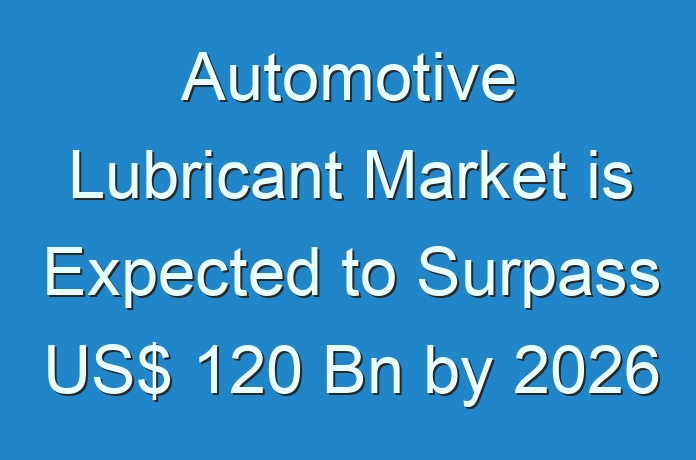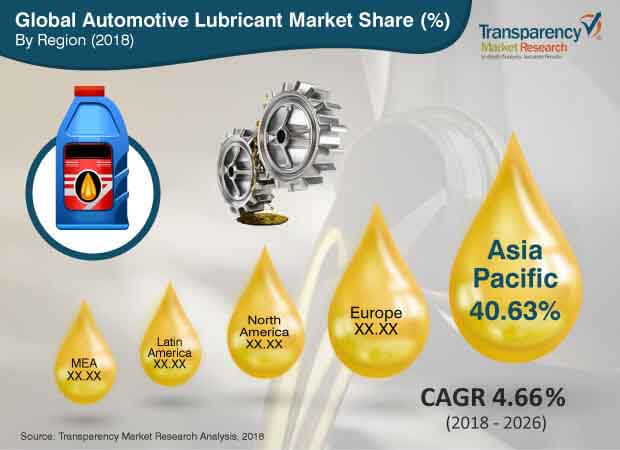
Automotive Lubricant Market – Snapshot
Automotive lubricants are predominantly utilized to reduce friction and enable smooth functioning of a vehicle. They are also used for transfer of heat, transmission of power, and protection against corrosion and rust.
Rise in number of on-road vehicles is a major driver of the automotive lubricant market. Rising dependency on private transport, economic stability, and increasing consumer affordability are boosting the usage of vehicles, which in turn is driving the demand for automotive lubricant. The average age of vehicles has increased to 11 years. Presence of ageing vehicle fleet improves the maintenance scope, thus driving the automotive lubricant market. OEM recommendation on usage of quality lubricants, such as synthetic/ semi-synthetic oil as they offer better lubrication than mineral oil, is expected to boost the demand for quality lubricants. Rise in consumer awareness and affordability is driving the usage of high quality lubricants, thus boosting the market of automotive lubricant. Government bodies are establishing minimum performance standards for lubricants in order to control rising emissions. Thus, prompting the utilization of low viscosity lubricants such as synthetic / semi-synthetic oil. Synthetic / Semi-synthetic oil has longer drain intervals as compared to mineral oil and hence, are being increasingly preferred by consumers. Moreover, synthetic/semi-synthetic oils account for a higher share of the market share, in terms of revenue, as these oils are more expensive than the mineral oils.

Request A Sample – https://www.transparencymarketresearch.com/sample/sample.php?flag=S&rep_id=9052
Rising sales of electric vehicles is expected to decline the consumption of automotive lubricant. Battery electric vehicles eliminate the need for engine oil due to the absence of the IC engine. Furthermore, electric vehicles have fewer reciprocating parts and hence, rising adoption of electric vehicles is expected to hamper the automotive lubricant market.
The global automotive lubricant market has been segmented based on product type, base oil, vehicle type, sales channel, and region.
Based on product type, the global automotive lubricant market has been classified into mineral oil, synthetic/ semi-synthetic oil, & bio-based oil. The synthetic/ semi-synthetic oil segment is anticipate to expand at a high growth rate during the forecast period owing to the rise in demand for quality lubricant and increase in stringency in emission norms. The bio-based oil segment accounted for a relatively minor share of the global automotive lubricant market. Performance challenges and their high price have hampered the segment. However, rise in the number of researches adopting bio-based oil on a large-scale, in order to find crude alternatives, is expected to propel the segment during the forecast period.
More Trending Reports by Transparency Market Research – https://www.prnewswire.com/news-releases/automotive-braking-system-market-to-touch-us107-bn-by-2026-introduction-of-new-technologies-to-boost-market-prospect-noted-tmr-300821681.html
In terms of base oil, the global automotive lubricant market has been bifurcated into engine oil, manual transmission fluid, and automatic transmission fluid. The engine oil segment held a dominant share of the market share in 2017 due to its low drain interval time. Engine oil is generally replaced at 10,000 to 15,000 miles and hence, corresponds to high demand. Growing preference for automatic transmission among consumers is boosting penetration of automatic transmission, such as dual clutch transmission, continuously variable transmission, and torque converters. Thus, the automatic transmission fluid segment is projected to expand considerably during the forecast period.
Based on region, the automotive lubricant market has been segmented into North America, Europe, Asia Pacific, Latin America, and Middle East & Africa. Asia Pacific is expected to dominate the global automotive lubricant market owing to the rise in usage of vehicles in the region. Latin America is also witnessing rapid economic growth and hence, rise in sales of light vehicles and heavy vehicles in the region is boosting the automotive lubricant market in Latin America.
Key players operating in the global automotive lubricant market include Royal Dutch Shell plc, ExxonMobil Corporation, BP p.l.c., Chevron Corporation, Total S.A.., Sinopec Corporation, Fuchs Lubricants Co., LUKOIL, Phillips 66 Company, Valvoline LLC, Repsol S.A., JXTG Nippon Oil & Energy Corporation, Bharat Petroleum Corporation Limited, Indian Oil Corporation Limited, Petrobras, and Morris Lubricants. The automotive lubricant market was being earlier dominated by national oil & gas companies; however, the market is witnessing increased penetration of independent private companies.
Ask for Discount on Premium Research Report With Complete TOC at – https://www.transparencymarketresearch.com/sample/sample.php?flag=D&rep_id=9052
The demand within the global automotive lubricants market is poised to increase at a noticeable pace in the times to follow. The quest of the automobile industry to foster quality and resilience in its technologies and offerings has created increased demand within the market. Lubrication is an effective technique for ensuring that automobile parts and engine do not undergo rusting. Besides, weather attacks can also be prevented through the use of effective lubricants on car engines and automobile parts. The automobile industry has embraced quality manufacturing as a key tenet, pushing market vendors to elevate their gradient of knowledge.
- Several authorities and organizations have been accredited by the state to test the effectiveness, strength, and quality of automobile manufacturing. This has made it mandatory for large automotive companies to ensure seamless quality in manufacturing.
- The use of automotive lubricants has been researched to increase the durability of automobile parts. This factor shall create new avenues for growth across the global automotive lubricants market. The high-headedness of car manufacturers in ensuring high-strength output during manufacturing has also aided market expansion.
- Several quality certifications have been issued by the concerned authorities to foster resilience across the automotive industry. This has also created new pathways for growth across the global automotive lubricants market. Consumer knowledge has also played a vital part in propelling sales across this market. The awareness of the masses about the various technologies used for quality enhancement in automobiles has prompted automobile manufacturers to use automotive lubricants.
The automobile industry is a safe haven of investment for several entities and stakeholders. The coronavirus pandemic has caused disruptions across the industry, but several new and innovative strategies introduced by automobile companies have emerged as saviours for the industry. Henceforth, the global automotive lubricants market is set to move along a lucrative pathway.
Request for covid19 Impact Analysis – https://www.transparencymarketresearch.com/sample/sample.php?flag=covid19&rep_id=9052





